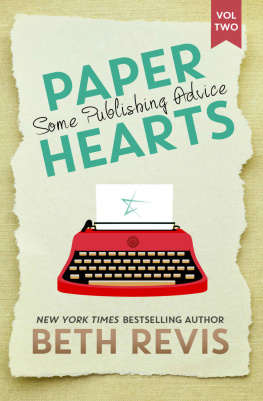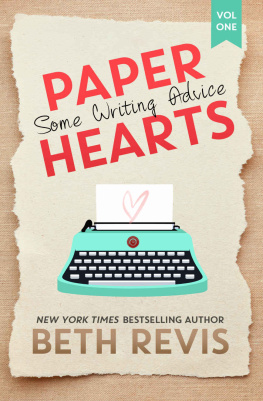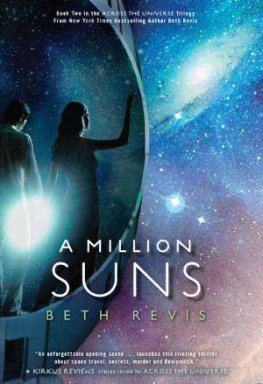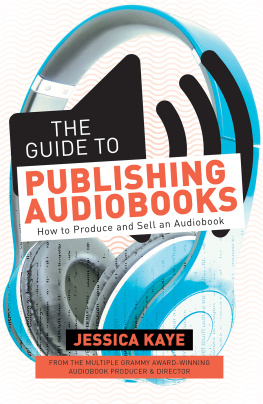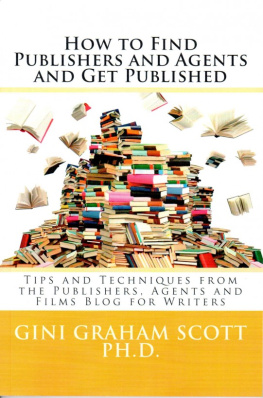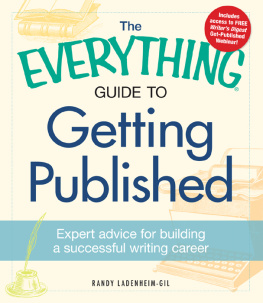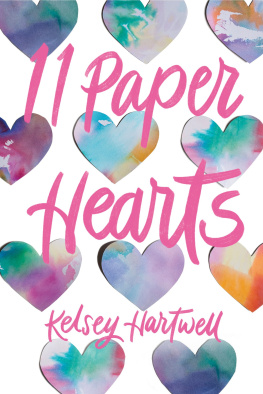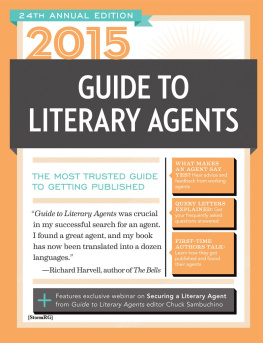Table of Contents
PAPER HEARTS, VOLUME 2 SOME PUBLISHING ADVICE BETH REVIS

CONTENTS
PAPER HEARTS, Vol 2: SOME PUBLISHING ADVICE
Copyright 2015 by Beth Revis
Cover design by Hafsah Faizal
www.bethrevis.com
www.iceydesigns.com
Publisher disclaimer: The material in this book is for informational purposes only. The author and publisher expressly disclaim responsibility for any negative effects that result from the use or application of the information contained in this book. Use discretion when making decisions regarding writing and publication of your work.
All rights reserved.
No part of this publication may be reproduced, stored in, or introduced into a retrieval system, or transmitted, in any form, or by any means electronic, mechanical, printing, recording, or otherwise, without the express written permission of the publisher prior to, except for the use of brief quotations in a book review. Electronic versions of the book are licensed for the individuals personal use only and may not be redistributed in any form without compensation and approval to and by the author. The scanning, uploading, and distribution of this book via the Internet or via any other means without the permission of the publisher is illegal and punishable by law.
Your support of the authors rights is appreciated.
First paperback edition: 2015
ISBN: 978-0-9906626-7-9 (print)
ISBN: 978-0-9906626-8-6 (ebook)

Created with Vellum
This book is dedicated to the writers
who, like me, could paper their
walls with rejections.
Dei gratia.
A NOTE ABOUT WEBSITES
THROUGHOUT THIS BOOK, the author occasionally refers to websites for further reading and resources. Please keep in mind that web content continually changes, and the author cannot control this.
FOR ADDITIONAL ONLINE RESOURCES, visit http://bethrevis.com/paperhearts
INTRODUCTION
Welcome to the world of publishing. BYOB.
ONE
IF YOURE HERE
IM SORRY.
Writing is a deeply personal art form that is often introspective and taps into who we are as a person.
Publishing is a soulless business thats worried about the bottom line.
Although they go hand-in-hand, writing and publishing are two entirely different beasts. Regardless, for many writers, the goal after finishing the novel is to get it published. But heres the thing that you need to remember throughout your publishing journey: Your dream lies in the hands of someone else. You are not in control.
This is true of whether youre seeking traditional publicationin which case you need an agent, then an editor, then the support of your entire publishing houseor whether youre pursuing self publishing and have to establish an audience or languish away with no readers. Either way, part of your success is determined by other people.
Of course you have a role in making your success happen. You have to write the best book possible. Thats the thing you controlthe only thing.
Because everything else? Out of your hands. You cant change the market that may not want your book right now. You cant change the agent who had a bad day and wasnt in the mood for your query. You cant change the publishing house that markets the book poorly. You cant change the stigma around self publishing. You cant change the difficulty you face in getting exposure, finding readers, building an audienceand then doing it all over again with the next book.
Thats what makes publishing so hard. Theres so much that you have no control over.
So when publishing gets you downand it definitely willremember the one thing you can control. Your art. When in doubt, go back to your story. Write. Dont forget that the writing always comes first.
TWO
HOW DO YOU KNOW YOURE READY?
THE ADVICE in this book assumes one very important thing: Your book is ready to be published.
Its often very hard to balance the art side of writing and the business side of publishing, whether you choose to self publish or traditionally publish. But before we even talk about self or traditional publishing, we should address the most common question writers ask:
Is my book ready to be published?
Knowing when your book is done isbasically impossible. Its hugely difficult for a writer to analyze her own work because the writer carries around in her head everything that didnt go into the book as well.
And if youre like most people, youll never think your book is ready.
Heres my process in getting a book towell, not complete, but as complete as its possible for a story to be. I dont do this for every book, but particularly if I know there are problems, I work this way.
Step 1: Finish a complete draft. If I think its close to what it should be, I go ahead and send it to critique partners here, and then use their notes to proceed in the following ways. If I know there are issues, I go straight to the following steps, then send to critique partners and repeat as necessary.
Step 2: Take at least a week off from the book to gain perspective and step back from the forest in an effort to see the trees. Meanwhile, print a copy of manuscript. I edit better on paper than on screenand if its a particularly difficult book, I will often swap fonts to help make the book look even more alien and make it easier to see it as a work rather than an extension of my mind.
Step 3: Make two columns on several pieces of paper. On the left side, I write down a few very basic lines of what happens in each chapter, summarizing it as I read through the novel.
Step 4: On the right column, in-line with each chapter, I write out what should happen. I dont outline while drafting, so typically I wander off and lose my pacing or drop plotlines, etc. So the right column is really about getting the book to where it needs to be.
Step 5: Revise based on that, send to critique partners, repeat as necessary.
In extreme measures, Ill reverse outline or otherwise work to shape the book together. If theres one thing Ive learned about my particular writing method, its that its never right the first time.
But theres also a time when I start to realize that the thing is what it is, and theres no going back. So I begin to accept that the book is complete when:
Critique partners arent presenting problems, but opinions. There comes a point where the only thing readers suggest is not really an improvement to the book but a difference of opinion. An example of this is: The love interest for the heroine is hot, but I prefer blondes. Changing hair color doesnt change the story; the critique partner has nothing really to say substantive to the book other than throwing out a few irrelevant opinions.
Note: Dont rely on this as the sole indicator that your book is perfect; sometimes you just dont have a very discerning critique partner.
Critique partners are only suggesting changes that are fundamentally against what youre trying to say with the book. If the whole point of your book is a bittersweet ending and they want a happily ever after, youre not really getting to a point where the story needs work; it just doesnt work for that specific reader.
Note: Not that you should entirely dismiss your critique partners. Their ideas may make your work more commercial, but you need to decide if you want to compromise your original vision for the work to be more marketable or keep it the way you want it.
Whenever you work on the book, youre doing nothing substantial to edits. You may swap some sentences or change some grammar, but on a story-level, youre really not changing anything. Let go. Youre just letting the story sit there and fester at that pointdo something with it.
Next page
